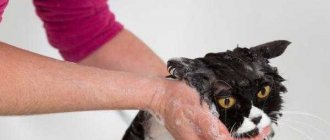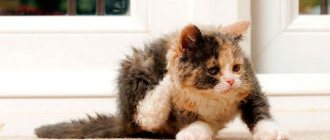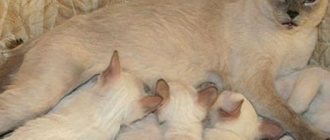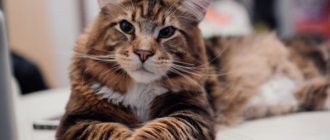Why do cats lick themselves?
The animal pays a lot of attention to its cleanliness, and if there is a piece of dried food or dirt on the fur, it will certainly need to be removed. For this, cats use not only their tongue, but also their teeth, biting dirt out of their fur.
Cats always take care of themselves; for them, clean fur, free of foreign odors, is of great importance. This is why cats lick themselves before going to bed or under other circumstances.
In the process of washing, the cat uses not only its tongue, but also its paws, which it licks. He uses his paws to wash hard-to-reach places on the head, neck, etc. The animal may look completely clean, and one wonders why the cat is constantly licking itself.
There are several explanations for this process:
Stimulation of special glands
The cat constantly licks itself - the reason for this behavior may be stimulation of the sebaceous glands. On the head of every furry pet there are sebaceous glands that produce sebaceous secretions. Thanks to this substance, the wool always remains lubricated and protected from moisture. By licking themselves with their tongue, cats spread the secretion over the entire surface of their fur.
The cat constantly licks itself for another reason. The secretion of the sebaceous glands contains cholesterol. When exposed to the sun, it becomes vitamin D. With its help, the body accumulates phosphorus and calcium. As a result of regular licking, the animal stimulates the process of producing such necessary elements.
Licking plays an important role in keeping the body and coat clean. Using this procedure, the animal removes dead parts of the fur. Cats shed in the spring and autumn, or after a serious illness. Too dry air in the apartment negatively affects the condition of the coat - it dries out and begins to fall out. Dead particles should not linger on the body, otherwise this will lead to the appearance and spread of dermatological diseases.
By origin, all cats are hunters. It is important for them to maintain their body odor. Why cats lick themselves - to stop smelling like a person, even when it is the owner.
Thermoregulation
Regularly using your tongue on your body helps control and regulate your temperature. An animal's fur is a protective layer that helps maintain proper body temperature. This explains why cats lick themselves - they need to keep their coat clean at all times.
By licking the fur with its tongue, the cat distributes tufts of fur in different directions. This is how the animal independently regulates the required body surface temperature. In the cold season, the pet secretes more saliva during the washing process, wetting the fur more abundantly. An even denser insulator is created.
Another purpose of washing is cooling. Many mammals sweat to reduce their body temperature. Cats have sweat glands, which, due to their thick fur, do not bring relief to the pet. The animal smoothes the hairs so that space is formed between them. The air penetrating through the villi cools the body.
Reasons for this behavior
In cats, constant licking of the genitals can be caused by inflammation of the prepurcial sac - the so-called skin fold of the foreskin that forms the space between the head of the penis and the skin. The folds of skin contain preputial lubricant that surrounds the cat's penis.
In a healthy animal, a small amount of liquid in the form of whitish-yellow smegma, the secretion of the glands of the foreskin, may occasionally accumulate along the entire perimeter of the preputial opening. Such discharge is considered normal by veterinarians. If for some reason an inflammatory process begins in the area of the foreskin, then this fluid includes inclusions of blood, pus or urine.
The reasons why a cat licks its tail may be as follows:
- Disease of the foreskin, including the occurrence of neoplasms (cancer) in this area, mechanical damage, balanoposthitis (inflammation of the foreskin).
- Diseases of the urethra: trauma, the formation of stones and their subsequent passage, neoplasia.
- Bladder diseases: stones, infectious inflammations, neoplasms,
- Pathology of the prostate gland: prostatitis, cysts, hyperplasia, neoplasms, abscess.
- Coagulopathy (bleeding) and thrombocytopenia that occurs in parallel with it (a decrease in the level of platelets in the blood) - such an ailment can be a consequence of poisoning with rat poison.
- Urinary incontinence - occurs due to displacement of the ureter, or improper functioning of the sphincter, which is responsible for the amount of urine released.
- The cat simply performs part of his daily toilet routine by thoroughly licking his genitals after going to the toilet.
- An animal can lick a wound under its tail. Surely every person has heard the point of view that a cat always heals itself by licking sore spots.
- A cat may lick under its tail due to the fact that it suffers from constipation; the painful sensations create constant torment for it, from which the pet tries to get rid of it in all available ways.
- Itching in the anus can also cause excessive licking under the tail; in this case, the owner should pay attention to the cat’s feces, if it contains traces of helminthic infestations, this particular cause must be gotten rid of.
- A cat may start licking its tail as a result of being in a stressful situation: moving to a new place of residence, castration, remodeling a house, having new family members or pets - absolutely all innovations can cause a cat to panic and plunge it into a depressive state.
Normal or pathological?
Normal cat hygiene is licking all fur several times a day, and briefly washing after contact with other animals or people. At the same time, the cat behaves calmly and relaxed, she is focused on the cleanliness of her coat.
A disease should be suspected if any movement of the animal is accompanied by licking of fur. At the same time, the cat behaves restlessly, is irritated or feels discomfort. This behavior may indicate itching or pain that the animal is suffering.
If a cat constantly licks itself, the cause of this phenomenon is:
Poisoning with pyrethrins and pyrethroids
Pyrethrins are insecticides of plant origin, which are obtained from certain types of plants (Dalmatian chamomile, chrysanthemum, tansy). In veterinary medicine, permethrin is actively used for cats (at 0.5-1% concentration in anti-flea shampoos, collars, drops, but in other proportions it is considered poison).
This is explained by the fact that in a cat’s body, permethrin does not break down into harmless compounds (as it does in dogs) and exhibits a toxic effect on the nervous system, which leads to prolonged convulsions and death.
This is why owners should be aware that permethrin dog drops should not be used on cats, as it can kill them.
Attention! If a cat licks flea drops containing permethrin applied to a dog upon contact, this will also cause poisoning. If a cat and a dog live together in the house, then it is better to buy insectoacaricidal products with other components.
Examples of existing products for cats with permethrin (their use is permissible only if the instructions are strictly followed):
- drops on the withers “Clandestine for cats” (1% permethrin);
- “Clandestine” universal powder (0.4% permethrin);
- spray "Clandestine" for cats and dogs (0.35% permethrin);
- anti-parasitic shampoos of the “Clandestine” brand (0.4% permethrin);
- anti-flea collars “Clandestine maximum” for cats (1% permethrin);
- “Pchelodar” – universal shampoo against fleas and ticks (0.25% permethrin);
- insecticidal shampoo for cats and dogs “Fitoelita” (0.3% permethrin);
- flea shampoo “Lapushka” (0.4% permethrin).
Pyrethroids are synthetic analogues of pyrethrins. Deltamethrin and etofenprox are used for domestic cats. Examples of drugs:
- Lugovoy shampoo for cats and dogs (deltamethrin 0.01%);
- drops for fleas in cats brand “Rolf Club 3D” (etofenprox 15%);
- butox 50 concentrate for preparing a solution (deltamethrin 5%).
Recently, due to frequent cases of poisoning in cats by these substances, many manufacturers of veterinary insecticides are discontinuing the production of certain drugs or replacing the formulation.
Symptoms
So, what happens if a cat licks flea drops that contain pyrethrins and pyrethroids:
- Half of the cats experience overexcitation, which is expressed in prolonged convulsions and twitching of the limbs;
- trembling;
- saliva is produced profusely;
- there is a loss of orientation in space;
- body temperature rises;
- pupils dilate;
- temporary hypersensitivity appears;
- coordination of movements is impaired;
- heart rate increases;
- gagging is observed;
- lethargic sleep may occur.
Therapy
Pyrethrins have no antidotes, so treatment is aimed at removing toxins from the cat's body.
If the poison has entered the digestive system, then you need to start with the administration of emetics or gastric lavage. At home, you should pour warm water into the cat’s mouth to induce vomiting, then give adsorbents (Smecta, Enterosgel).
If pyrethroids are ingested externally in a toxic dose (when treating a cat with dog drops), you need to wash the animal several times with regular shampoo and then feed it with adsorbents.
If a cat has licked off flea drops and has convulsive reactions, you should immediately go to the veterinarian, he will provide first aid, prescribe appropriate treatment, or leave the animal in a hospital under his supervision.
As a rule, cats recover in 3-5 days if first aid is provided to them in a timely and competent manner.
Symptoms of the presence of parasites
Animals show increased attention to their own hygiene in the presence of parasites - fleas or ticks.
At the same time, the cat is constantly itching, shaking itself off and licking itself. You can suspect parasites by carefully examining the animal's fur. If no fleas are found, it is recommended to inspect the coat again, paying attention to the areas behind the ears and on the neck. A possible cause of discomfort may be nits, which can be difficult to detect with a quick examination. Excessive peeling of the skin in the absence of visible parasites may indicate a mite.
Ringworm and fungi
Ringworm in animals appears as small patches of baldness. In this case, scabs or erosion may be present on the skin, but this depends on the causative agent of the disease.
Quite often, the reason that an animal licks itself more often than usual is a fungal infection. It is impossible to identify the fungus without special equipment, but dry skin and flaking can help you suspect the disease. It is these symptoms that cause discomfort to the cat, in response to which he constantly licks himself, itches and chews his fur.
Upon careful examination, you will notice the following signs on the skin:
These symptoms are characteristic of various fungal infections, including lichen. In this case, hair loss can be caused both by the characteristics of the disease and by the actions of the animal itself. Often, in response to itching, cats gnaw out islands of fur, trying to reach the skin with their claws.
Treatment of fungal infections is carried out with the help of antimycotic drugs. Shampoos and ointments used to treat people are usually prescribed - Nizoral, Ketoconazole, Clotrimazole.
Treatment
Treatment is based on the results of the tests, which will help establish the true clinical picture of the cat’s disease.
If the cat turns out to be absolutely healthy, the owner should not even worry about the fact that the cat is constantly licking its genitals. Let him do this for his own health, because it’s nice to have a clean cat in the house.
If this habit is caused by the animal having a disease, then you should follow all the recommendations of the treating veterinarian and fight for the health of your pet.
If the presence of a malignant neoplasm is detected under the tail, the animal will be prescribed a course of a drug such as Fitoelita Metastop and chemotherapy.
Urinary tract diseases should be eradicated with the help of drugs such as Phytoelita Healthy Kidneys, KotErvin.
Also, veterinarians often prescribe antibiotics in such cases - Sinulox, Amoxiclav, Cefazolin, Tsiprolet.
Fenbendazole, Pyrantel, Albendazole will help cope with helminthic infestations.
Levomikol ointment can help heal wounds under the tail; in this case, the cat should be wearing an Elizabethan collar, since this product has an unpleasant bitter taste.
- Published in
- Health
Useful materials:
- The cat has cancer Stages of mammary gland cancer in cats Like in humans, cat mammary cancer has ...
- Cat's eye Causes and signs of various types of eye diseases in cats Cats have many eye diseases. Necessary…
- Cutaneous horn General description of the disease Cutaneous horn on the forehead or face (ICD 10 code - L57.0) -...
- Bald patches on a cat For many people, pets, be they cats or dogs, for example, have become not just animals,…
Dermatitis in cats
Itching and pain of the skin can be caused by dermatitis.
This disease is caused by an immune disorder and the activation of opportunistic microorganisms on the animal's skin. Dermatitis is always accompanied by inflammation of the epidermis. With moderate inflammation, the animal becomes restless, itching, and the cat constantly licks its fur. Suspecting the disease at this stage is quite problematic.
In most cases, dermatitis is accompanied by visible symptoms - severe peeling of the skin, the formation of rashes, wounds and erosions. The rashes are most often localized on the pet's face, near the ears and on the neck.
Treatment is carried out using external agents, but only after identifying the pathogen.
Endocrine disorders
In cats with metabolic disorders, as well as in recently spayed or neutered animals, the appearance of itching and flaking of the skin may be associated with endocrine disorders. As a rule, there are no specific symptoms other than restless behavior and constant licking of fur.
Such a violation can only be suspected by a change in the animal’s behavior. For treatment, a gentle diet and special vitamin supplements are used. Only a veterinarian should prescribe such medications.
I graduated from the National State Agricultural Academy and have been working as a veterinarian for 8 years.
In my free time, I write articles about the diagnosis and treatment of cats.
Feel free to ask questions in the comments, I will try to answer everything.
Source
Poisoning with FOS substances and carbamates
Organophosphates (diazinon, tetrachlorvinphos) and carbamates (propoxur) are considered obsolete and toxic agents for the control of insects and ticks in cats.
Since 2004, they have been used mainly in agriculture. However, some modern pharmaceutical companies continue to produce cat drops and flea collars with these substances due to their proven effectiveness and good sales. Examples:
- flea drops “Flea Drops” from Beaphar with the active ingredient diazinon (which are no longer sold in Russia, but are available in other countries);
- insecticidal drops “Best friend Ectostop” on diazinon;
- anti-parasite collars from Hartz (tetrachlorvinphos).
Several years ago in the Russian Federation, the drug “Dana” was produced with diazinon, but today the API-SAN company has changed the composition of flea drops (fipronil + auxiliary components).
Carbamates (propoxur) are present in some flea collars for cats from the Bolfo brand, and poisoning can occur if the cat licks or chews the accessory.
Clinical symptoms
If it happens that the cat licked the flea drops with diazinon, then clinically this is expressed by the following signs:
- excessive salivation from the mouth (a characteristic sign);
- lethargy, apathy;
- frequent urge to vomit (expressed as smacking and licking);
- loose stools;
- complete lack of appetite;
- muscle weakness and convulsive manifestations;
- rapid or, conversely, weakened heartbeat (depending on the dose);
- shortness of breath, rapid breathing with an open mouth;
- constant “small” trips and thirst.
A local allergic reaction is expressed in redness of the area where drops are applied, development of irritation, itching, and scratching.
Treatment
In such cases, the first thing to do is to prevent further absorption of toxins from the skin by washing off the product using a cleansing shampoo with a strong degreasing effect.
Next, it is recommended to rinse the cat’s mouth and stomach and induce vomiting by injecting a large amount of water. After washing, sorbents (activated carbon, Smecta, Enterosgel) are introduced.
If convulsions or muscle tremors appear, you should immediately take the cat to the veterinarian, he will administer intravenous anticonvulsants to reduce agitation and other necessary drugs (Atropine, Diazepam), prescribe infusion therapy and a therapeutic diet.











